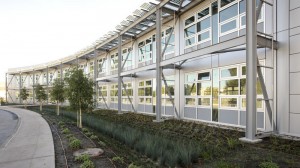
Did you know that NASA took on the project of creating the world’s greenest building? It’s called Sustainability Base and it’s located right in the heart of Silicon Valley. It boasts incredible energy efficiency and often puts energy back into the grid. And as it’s website says, it’s claimed to have been built to be “furnished with materials that are beneficial to your health”. I’m not entirely sure what that means, but it brings up a really important topic of how buildings affect human health. There is a lot of ongoing research in this area, including work that David talked about in this recent post. As David also said in this post, there is no mention of the microbes!
My recent post about water quality in green buildings discussed that what may be good for the environment may negatively impact human health in regards to green building engineering. It is obvious that human health is on the radar for NASA’s Ames Research Center, but the microbes are most definitely being overlooked. With the 2015 United Nations Climate Change Conference underway in Paris right now, there are no questions that all buildings will be making the shift to being more green. The scale of this upcoming change is HUGE. So wouldn’t it be disappointing if we knew that a simple engineering tweak would have prevented numerous infections in building from a pathogenetic specie of Legionella bacteria that was growing in their water recycling system?
It is common knowledge that occupant health is directly correlated with building health. It is also common knowledge that human health is directly correlated with each individual’s microbiome. So why the disconnect between building scientists and microbiologists? Well, a recent conversation with my twin brother, Matt, who currently works on building energy simulations with the Building Science Group, highlights some key points about this matter. First, he politely mentioned that microbes really aren’t that important when considering building design. What is important is designing HVAC systems that control humidity and provide adequate ventilation. Design is influenced by ways to reduce contaminants that are detrimental to air quality such as VOCs (volatile organic compounds) and mono-nitrogen oxides. In a way, the microbes in these buildings are determined by their environment rather than the other way around. In Matt’s words, “people design buildings so they don’t mold, and that they are thermally comfortable, but they don’t really design for a particular microbiome.” While Matt makes interesting points, it highlights the need for more conversations about design considerations as the microbiology of buildings change with the green building movement.
A good HVAC system is important to mantain good building health. But it does not help when “accidents” occur in healthy buildings: leaks, water intrusion, structural failures, aging… The main task for building design is to keep water away, or at least avoid major impact by choosing appropriate building materials (building microbes are mainly vegetarians and love green stuff!) moisture detectors in wet rooms in hidden structures, and the possibility to open these hidden structures for inspection. Think as a doctor when designing a building, not only as an engineer